Happy Friday, everybody.

Now go wash your eyes out.
Credit for the piece goes to Jewel Loree.
So that civil war in Syria thing, yeah, it’s still going on, folks. And lots of people—7,000,000 of them—have been forced to flee to either external or internal locations. Al Jazeera has attempted to put that number into context for Americans using US census data and maps.
Here is a look at both Philadelphia and Chicago for comparison’s sake. The interactive application has a few pre-selected options, or you can find your own US locale.

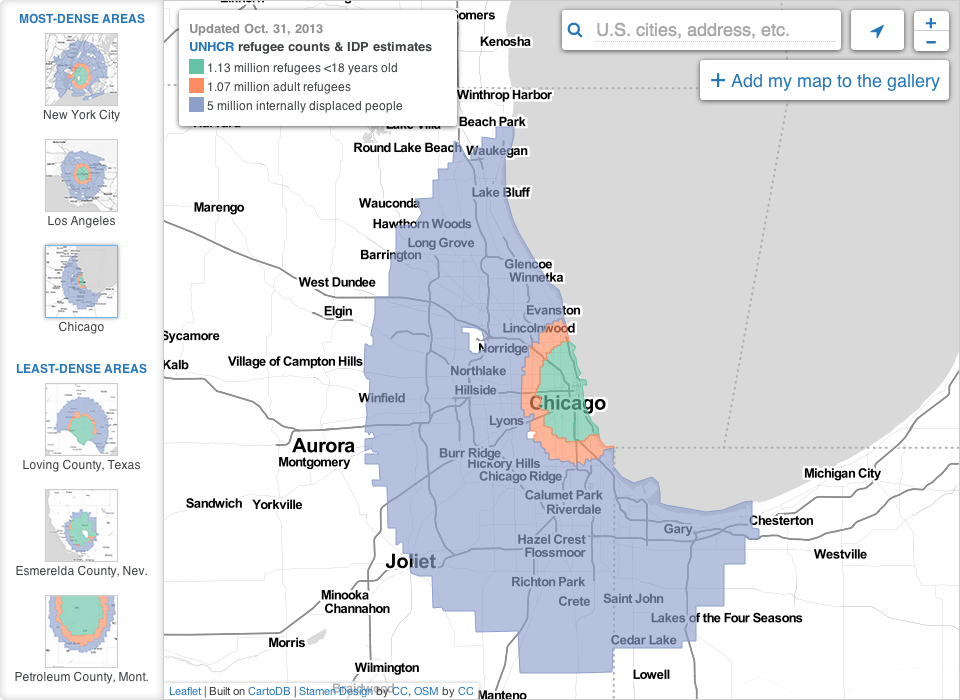
Credit for the piece goes to Michael Keller.
Last night was election night. Okay, maybe not the big midterm, but there were still a few interesting races. The one I want to look at it, however, is the gubernatorial race in Virginia. Maps are pretty much the default in big, statewide races like these and it is no surprise that the three screenshots here are use a map as an anchor component.
The Huffington Post uses a scatterplot to compare the margin of victory for Terry McAuliffe to that of Barack Obama in 2012. A technical flaw places the drop down menu atop the plot, unfortunately, but the component works to show differences in just one year.

Over at the New York Times, the Virginia results were given a nice overview. Here they used a text summary to explain the race in short. They used a small amount of space to show polling results over time. And then beneath the map they looked at recent elections across the state.
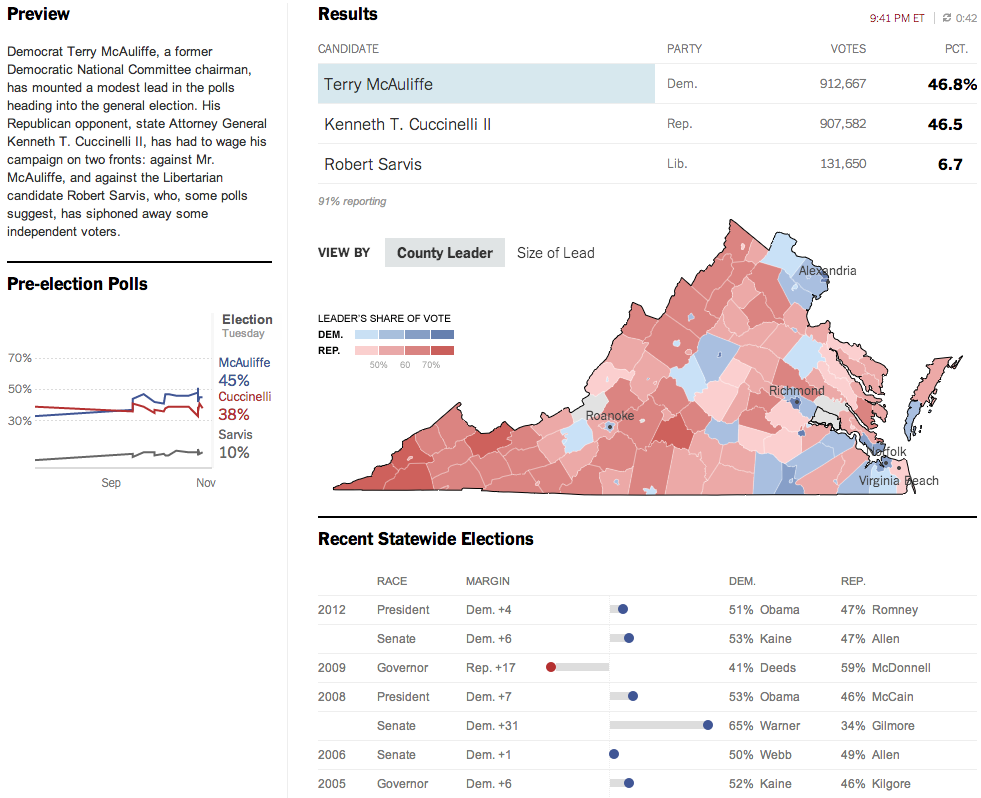
The Washington Post, which reports to the northern counties of Virginia, had a much simpler piece. They used solely a map to present the data.
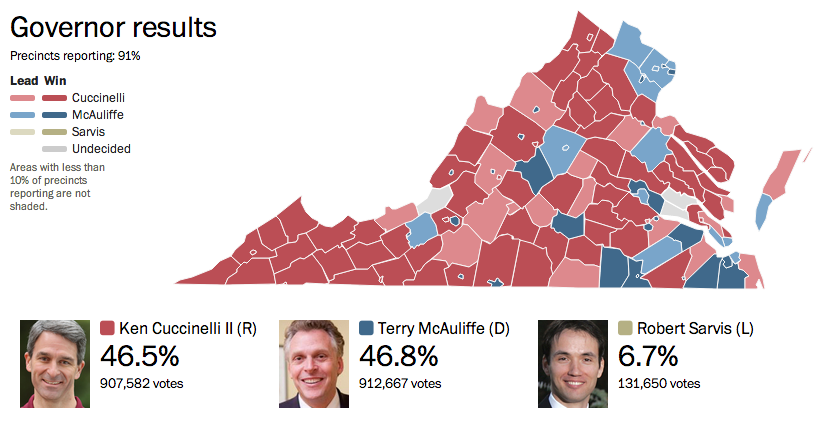
Credit for the Huffington Post piece goes to Aaron Bycoffe, Jay Boice, and Hilary Fung.
Credit for the New York Times piece goes to the New York Times’ graphics department.
Credit for the Washington Post piece goes to the Washington Post’s graphics department.
I didn’t see a lot of informative graphics regarding the shooting at LAX. But, here are two pieces. The first is from the Los Angeles TImes. Terminal 3 is rendered in three dimensions. Different buttons add views of the remainder of the airport.
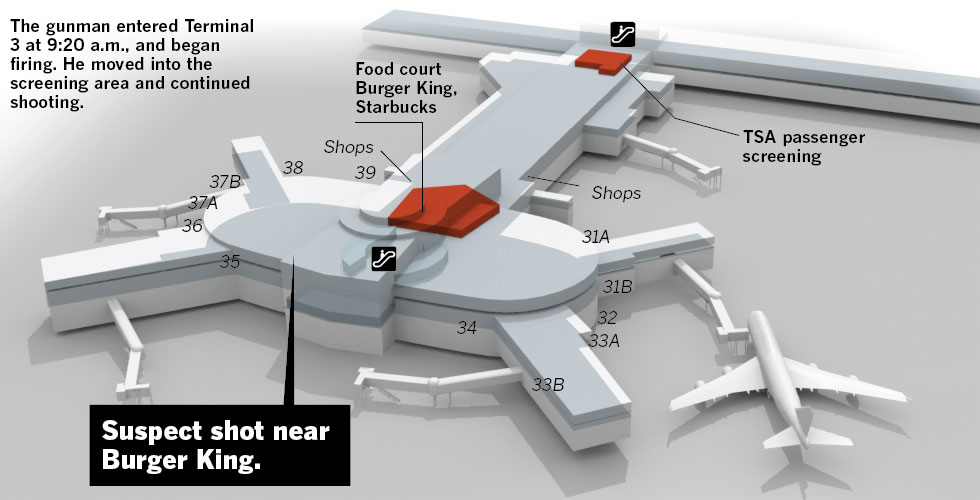
The Washington Post opted for a flat, two-dimension drawing in one graphic with both all of LAX and Terminal 3 in the same graphic.
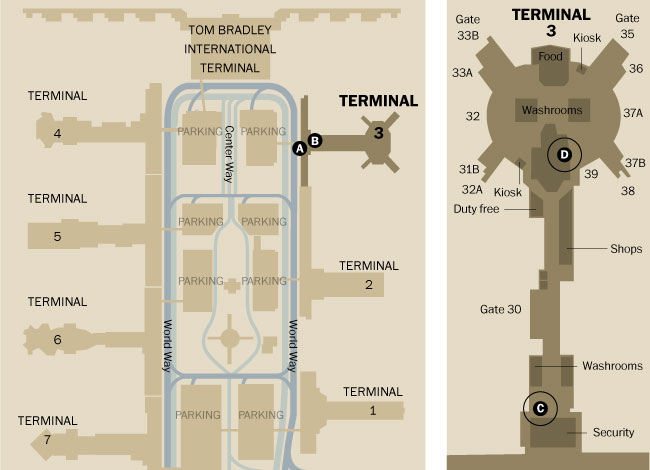
The thing about the three-dimensional rendering is that it adds too much complexity whereas the two-dimensional schematic strips most of it out. Is it important to know the specific details of a building? Or is it more important to see its general shape and an area inside of it?
Credit for the Los Angeles Times piece goes to Javier Zarracina, Raoul Ranoa, Lorena Iniguez, and Anthony Pesce.
Last week the Boston Red Sox won the 2013 World Series. I did a wee bit of celebrating and so I did not have the chance to post today’s post until, well, today. A company called Statlas charted each game of the World Series. One of my coworkers pointed me in the direction of these visualisations, unfortuantely I missed out on most of them for the playoffs. Here, though, is when I started feeling a lot less nervous about Boston’s chances for winning Game 6.
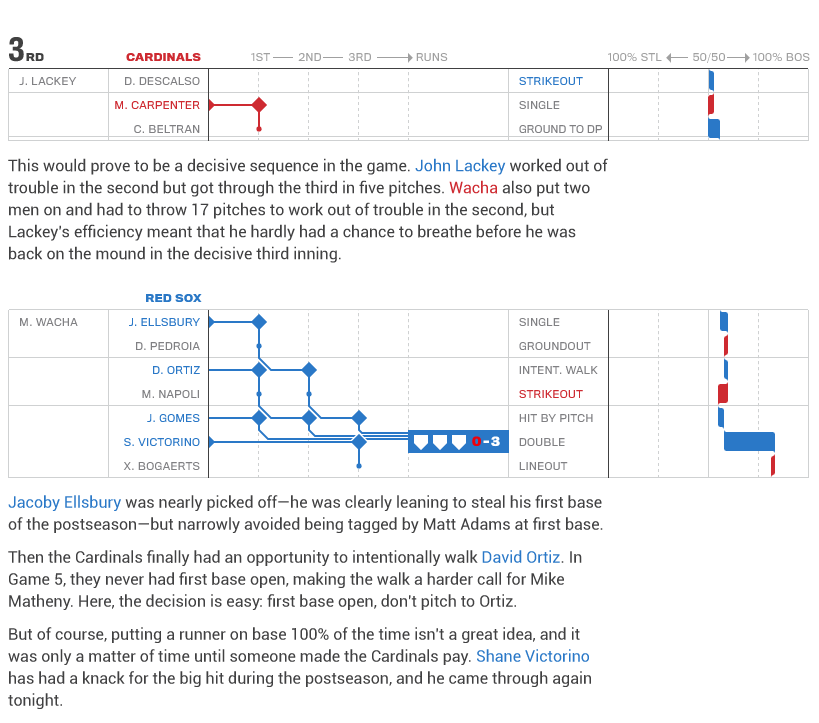
There is a lot to see and look at in these games. And I will be curious to see where Statlas takes these—if they take them anywhere—for the 2014 season. Baseball is a game rich with statistics and data and teams and fans are increasingly using them to play and understand the play in the games. It’s about time somebody starts doing some valuable visualisations.
Credit for the piece goes to Statlas.
The thing with the NSA spy scandal is not that it collects data on Americans. But it collects data on the Americans that the Americans that the Americans know. Three degrees of separation can actually be quite a few people whose privacy is violated in the name of security. The Guardian has an excellent piece that shows you as in you yourself—if you grant access to your Facebook profile—how many people could be investigated because you know them.
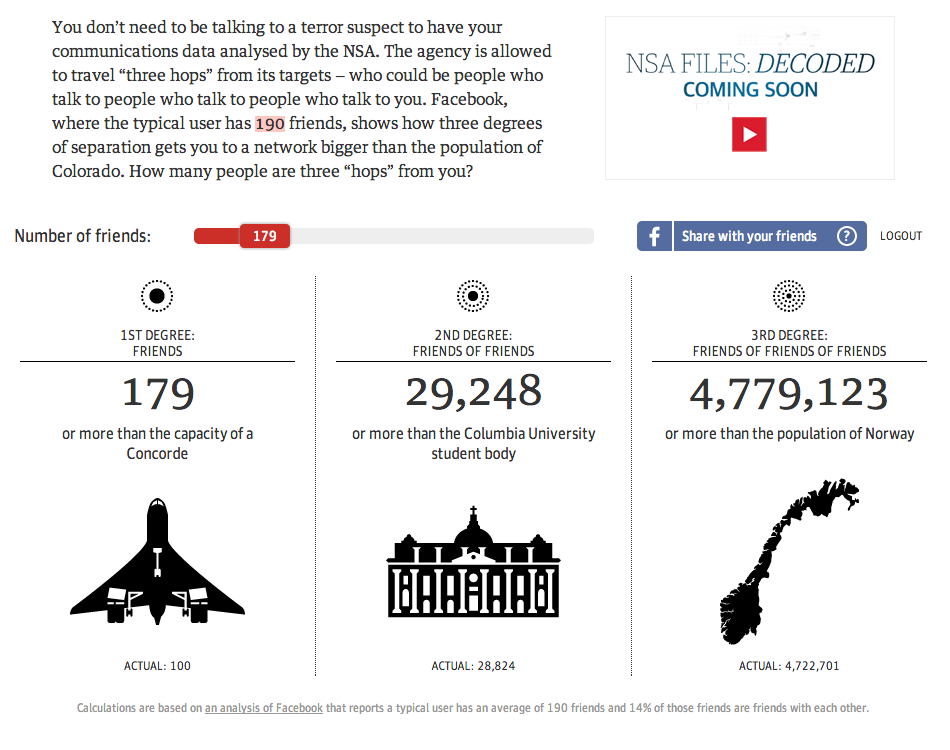
Well, I hate to tell you, Norway. But apparently, with me you are far from safe. Or at least a Norway-sized chunk of the American population. More seriously, this is a great piece that personalises an abstract sort of concept. Not just through the use of your own personal data, but by using (potentially) familiar items to contextualise scale. How many people is 190? Almost two Concordes worth. How many is 4,779,123 people? More than the population of Norway. You know, a country. Well done, Guardian.
Credit for the piece goes to the Guardian’s US Interactive Team.
I am not terribly familiar with local politics outside of my local areas. So the background and details of this piece escape me. However, this interactive graphic and story from the Los Angeles Times does a really great job of leading the reader through the story.
First, the piece starts with a general overview or flowchart of the network of connections. Mouseovers do a fine job of highlighting and filtering for the appropriate piece. For example, a person shows the entities to which he is connected whereas the entities show the people to which it is connected.

Secondly, the piece then goes in detail about the different connections. The example screenshot below shows how each story is highlighted by a red dot as the user scrolls down the page. When that story is highlighted, the network diagram to the left changes, either replacing the contacts or highlighting the contacts specifically noted in the story.

As I said at the outset, this is a very nice piece that step-by-step shows and explains how all the connections work while filtering out the momentarily irrelevant data. Very well done.
Credit for the piece goes to Byron Lutz.
Two and a half years ago an earthquake and then tsunami devastated Japan. But it was the tsunami that crippled the Fukushima nuclear power station and created the world’s worst nuclear disaster since Chernobyl. Unfortunately things are still not working properly and the plant is still leaking radioactive particles into the local environment. This interactive guide from the Guardian illustrates just what Tepco, the power company responsible for the plant, is trying to do to prevent further radiation from leaking into the ocean.

Credit for the piece goes to Paddy Allen and the Graphic News.
Today’s piece maps and charts comes from the Illinois Department of Public Health. The piece combines maps and charting components to detail preventable hospitalisations and emergency room use in the state of Illinois.

Ordinarily I would prefer just one map, however, in this case the designers realised that a regional map—with its larger surface area—need not be as large as the county map. Some additional elements worth noting is the area devoted to the human explanation of the categories, which might otherwise be difficult to understand.
Credit for the piece goes to Axis Maps.
This article on Yahoo by the AFP has an interesting graphic on the problem facing Australia of illegal arrivals via boat that, in part, probably cost Kevin Rudd and the Labor Party of Australia the recent election.
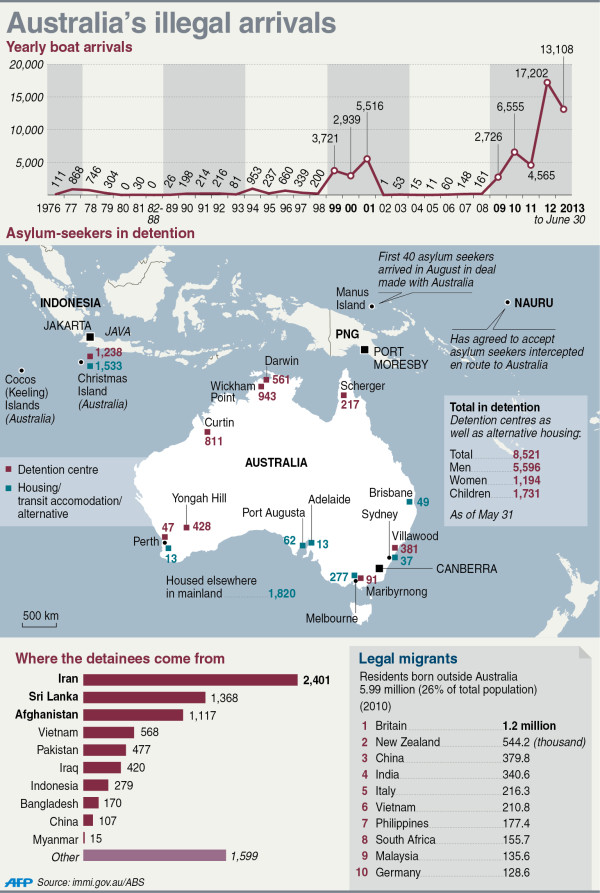
I like the overall graphic, but I feel that the data labels are unnecessary on the line chart and the bar chart. They distract from the overall shape of the data and are anyways hinted at by the axes labels within the charts themselves. Also, I am a bit unclear as to the meaning of the grey bars in the line chart.
Credit for the piece goes to John Saeki.